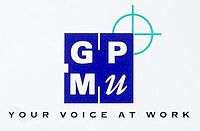Graphical, Paper and Media Union
The Graphical, Paper and Media Union (GPMU) was a trade union in the United Kingdom and Ireland between 1991 and 2005.
 | |
| Full name | Graphical, Paper and Media Union |
|---|---|
| Founded | 1991 |
| Date dissolved | 2005 |
| Merged into | Amicus |
| Members | 282,000 (1991[1]) |
| Key people | Tony Dubbins, General Secretary |
| Country | United Kingdom |
History
The GPMU was formed from the merger of SOGAT and the National Graphical Association (NGA) and claimed to be the world's largest media union, having over 200,000 members working in the print, publishing, paper, IT and media industries.
The general secretaries of both predecessor unions stood in the GPMU leadership election, with an agreement that the loser would become Deputy General Secretary. Tony Dubbins of the NGA narrowly defeated Brenda Dean of SOGAT, by 78,654 votes to 72,657.[2] Dubbins served as general secretary throughout the GPMU's existence, but Dean stood down after one year ;[3] in 1994, Tony Burke became Deputy General Secretary. The first General President was Bryn Griffith, former General President of the NGA, who defeated Danny Seargant of SOGAT.[2] Griffith was succeeded by Doug Douglas, following a controversial High Court case, when the union tried to ignore the ballot result in 1995.
Facing a decline in membership, in February 2004, GPMU opened merger negotiations with the skilled engineering, manufacturing and white collar union Amicus. In August 2004, results of a ballot of all members were released, showing 86% of members in favour of merger. The formal merger took place in early 2005, (at the same time the finance union Unfi joined Amicus) and GPMU became the semi-autonomous Graphical, Paper and Media industrial sector of Amicus. Tony Dubbins became the Deputy General Secretary of Amicus and Tony Burke became Assistant General Secretary of Amicus. Tony Dubbins was also the union's political head and Chair of TULO. He retired to Spain in October, 2008.
Amicus merged with the Transport & General Workers Union in May 2007 to form Unite the Union. The GPMU sector became the Graphical, Paper & Media Sector of Unite the union.
Tony Burke became the Assistant General Secretary of Unite responsible for the union's manufacturing section.
In 2014 faced with major changes to the print, communications and the media industries the Unite GPM sector merged with Unite's Information Technology and Communications sector to form the GPMITC Sector of the union.
A permanent display of memorabilia and the history of the print and papermaking unions of the UK and Ireland is housed at the Marx Memorial Library in Clerkenwell, London.
Election results
The union sponsored several Parliamentary candidates, many of whom won election. All such sponsorship arrangements ended in 1995, when the Labour Party changed its rules.[4][5]
| Election | Constituency | Candidate | Votes | Percentage | Position |
|---|---|---|---|---|---|
| 1992 general election | Bradford North | Terry Rooney | 23,420 | 47.8 | 1 |
| Clackmannan | Martin O'Neill | 18,829 | 49.1 | 1 | |
| Leeds North East | Fabian Hamilton | 18,218 | 36.8 | 2 | |
| Leicester South | Jim Marshall | 27,934 | 52.3 | 1 | |
| Manchester Central | Bob Litherland | 23,336 | 72.7 | 1 | |
| Newham North East | Ron Leighton | 20,952 | 58.3 | 1 | |
| Stretford | Tony Lloyd | 22,300 | 59.6 | 1 | |
| 1994 by-election | Bradford South | Gerry Sutcliffe | 17,014 | 55.3 | 1 |
References
- David Needle, Business in Context: An Introduction to Business and Its Environment, p.139
- Peter Bain and John Gennard, A History of the Society of Graphical and Allied Trades, p. 177
- "Sutcliffe, Gerard", Who's Who
- The Times Guide to the House of Commons April 1992. London: The Times. 1992. pp. 32–249.
- Brown, Colin (8 August 1995). "Labour to end union backing of MPs". The Independent. Retrieved 16 October 2018.
External links
- Unite
- Graphical, Paper and Media sector of Unite
- Catalogue of the GPMU archives, held at the Modern Records Centre, University of Warwick
- Catalogue of the Printing Machine Branch archives, held at the Modern Records Centre, University of Warwick